This article was co-authored by Rebecca Levy-Gantt, MPT, DO. Dr. Rebecca Levy-Gantt is a board certified Obstetrician and Gynecologist running a private practice based in Napa, California. Dr. Levy-Gantt specializes in menopause, peri-menopause and hormonal management, including bio-Identical and compounded hormone treatments and alternative treatments. She is also a Nationally Certified Menopause Practitioner and is on the national listing of physicians who specialize in menopausal management. She received a Masters of Physical Therapy from Boston University and a Doctor of Osteopathic Medicine (DO) from the New York College of Osteopathic Medicine.
wikiHow marks an article as reader-approved once it receives enough positive feedback. This article has 25 testimonials from our readers, earning it our reader-approved status.
This article has been viewed 2,457,270 times.
Having your period is nuisance enough without the added stress of a surprise visit. While there's no scientific method of determining exactly when your period will come, these methods below will help you estimate your menstrual cycle length and help you be prepared for the next one. Carrying pads or tampons around in your purse at all times is a simple but effective strategy to never be caught off-guard.
Steps
Keeping Track of Your Period
-
1Know what's normal. The menstrual flow itself can last anywhere from two days to a week, with the average being four days.[1] Spotting that occurs before your period generally does not count as part of the menstrual flow; only actual bleeding counts.
- It's normal for people with vaginas in their teens and 20s to have slightly longer cycles, for people in their 30s to have shorter cycles, and for people in their mid-40s to 50s to have shorter cycles still.[2] If yours varies wildly from month to month and you've had your period for longer than two or three years, it would be a good idea to see a doctor to make sure that you're not suffering from hormonal imbalances.
-
2Count the days. Count up the number of days between the first day of your period and the first day of the subsequent period. That number is your cycle length. For most people who have periods, it's 28 days, but a normal cycle can range from 25 to 35 days.[3]Advertisement
-
3
-
4Use an app. Consider using an online application like MyMonthlyCycles, MyMenstrualCalendar, or an app on your phone like Period Tracker. This kind of technology is great for helping your keep track of your period from the ease of your mobile phone.
-
5Use an online calendar/planning tool. Set up a Google calendar event and send yourself a reminder around the time your next period is scheduled. That way, you can write it down in the calendar when your period actually comes and compare the two dates. This will help you learn your body's normal cycle variances, as well as reminding you to be on the lookout for your period when it is scheduled to come.
Knowing Your Body
-
1Know the symptoms. Learn what symptoms are normal for people to experience during and just before their periods start. The following symptoms are experienced by many people during their menstrual cycle:[5]
- Irritability
- Mood swings and sudden crying
- Minor headaches
- Stomach aches
- Cramping in stomach, legs, or back
- Changes in appetite
- Cravings for particular tastes or foods
- Acne outbreaks
- Tender breasts
- Feeling tired or sleepy
- Back or shoulder pains
-
2Record your own symptoms. Every woman's cycle is unique. Record the symptoms you experience before and during each period to help you predict an upcoming period. Recognize the warning symptoms that frequently precede your period. Write down the symptom(s) you experience and their severity on each day.
-
3Talk to your doctor about any irregularities in your menstrual cycle. Irregular periods can be a symptom of many conditions that need medical attention. Some of the most common medical problems that cause irregular periods include:
- Pelvic organ problems like imperforate hymen or polycystic ovary syndrome[6]
- Irritable bowel syndrome
- Liver disease
- Diabetes
- Eating disorders like anorexia and bulimia
- Obesity
- Tuberculosis
-
4Take steps to regulate your period. If your period is irregular, you should see your doctor. Make sure you find a doctor you are comfortable talking to, as this can feel like a sensitive subject for some. Sometimes, there may be an underlying health issue causing irregularity; other times, irregular periods can be regulated with lifestyle changes such as weight loss or changing your type of birth control. [7]
Expert Q&A
-
QuestionWhen I got to the bathroom and wipe, there is blood on the toilet paper, but I don't bleed after that. Is this my period?
 Carrie Noriega, MDDr. Noriega is a Board Certified Obstetrician & Gynecologist and medical writer in Colorado. She specializes in women’s health, rheumatology, pulmonology, infectious disease, and gastroenterology. She received her MD from the Creighton School of Medicine in Omaha, Nebraska and completed her residency at the University of Missouri - Kansas City in 2005.
Carrie Noriega, MDDr. Noriega is a Board Certified Obstetrician & Gynecologist and medical writer in Colorado. She specializes in women’s health, rheumatology, pulmonology, infectious disease, and gastroenterology. She received her MD from the Creighton School of Medicine in Omaha, Nebraska and completed her residency at the University of Missouri - Kansas City in 2005.
Board Certified Obstetrician & Gynecologist It is hard to say exactly what this is since not all blood seen on toilet paper is from the vagina. Bladder infections or hemorrhoids can cause blood to appear on the toilet paper, too. If the blood is from the vagina it could be a sign that a period is going to start soon or it could be a sign of a vaginal infection. If you can't figure out what is causing this blood on the toilet paper you should see your doctor.
It is hard to say exactly what this is since not all blood seen on toilet paper is from the vagina. Bladder infections or hemorrhoids can cause blood to appear on the toilet paper, too. If the blood is from the vagina it could be a sign that a period is going to start soon or it could be a sign of a vaginal infection. If you can't figure out what is causing this blood on the toilet paper you should see your doctor.
Warnings
- If you have a severe stomach ache that spreads from your belly-button to your left side, contact a doctor right away. This is not regular period cramps, and is a sign of appendicitis.⧼thumbs_response⧽
- If you don't notice a consistent pattern in your menstrual cycle after recording it for several months, consider seeing a doctor to make sure you don't have any hormonal imbalances.⧼thumbs_response⧽
References
- ↑ http://www.webmd.com/women/tc/normal-menstrual-cycle-topic-overview
- ↑ http://www.webmd.com/women/tc/normal-menstrual-cycle-topic-overview?page=2
- ↑ http://www.webmd.com/women/tc/normal-menstrual-cycle-topic-overview
- ↑ http://www.girlshealth.gov/body/period/
- ↑ http://www.webmd.com/women/tc/normal-menstrual-cycle-topic-overview?page=2
- ↑ http://www.webmd.com/women/tc/missed-or-irregular-periods-topic-overview
- ↑ http://www.webmd.com/women/guide/treating-irregular-periods
- ↑ Rebecca Levy-Gantt, MPT, DO. Board Certified Obstetrician & Gynecologist. Expert Interview. 3 April 2020.
- ↑ Rebecca Levy-Gantt, MPT, DO. Board Certified Obstetrician & Gynecologist. Expert Interview. 3 April 2020.
About This Article
While there’s no certain way to know when your period is coming, you can get a good estimate by keeping track of your menstrual cycle with a calendar or phone app. When your period comes, mark down the date and count the days until the beginning of your next period. This range is the length of your cycle. For most women, a cycle is 28 days, but that number can be longer for young women and shorter for women in their 30s and above. Also, take note of physical symptoms like irritability, cramps, acne outbreaks, and breast tenderness, as these are common signs that your period is about to begin. For more help, like how to regulate your period, scroll down.

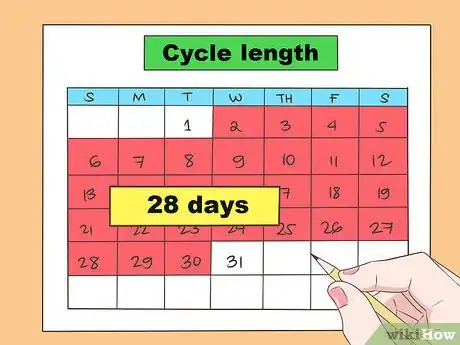


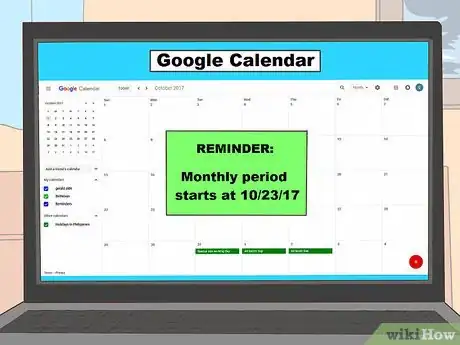

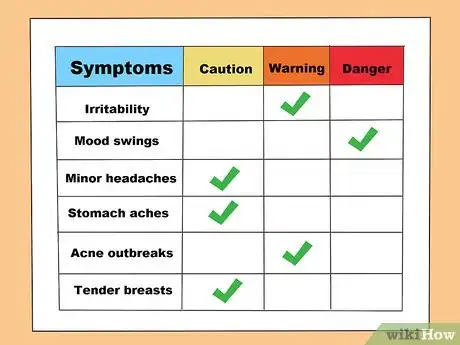
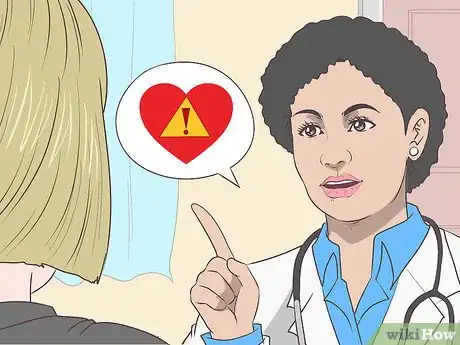



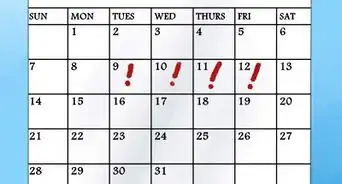









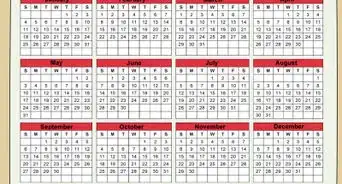













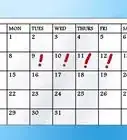




































Medical Disclaimer
The content of this article is not intended to be a substitute for professional medical advice, examination, diagnosis, or treatment. You should always contact your doctor or other qualified healthcare professional before starting, changing, or stopping any kind of health treatment.
Read More...